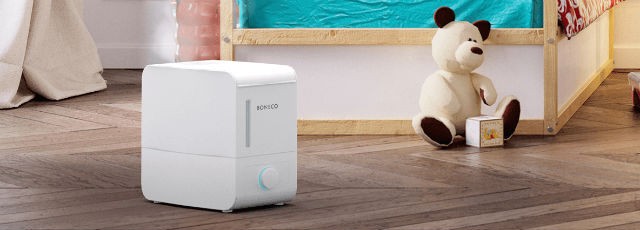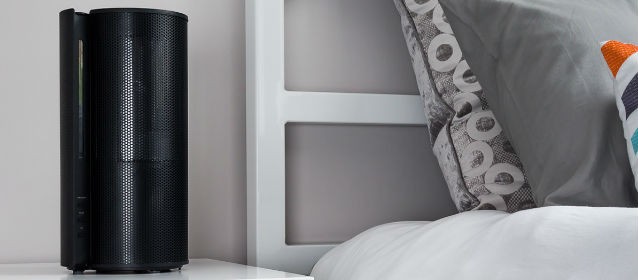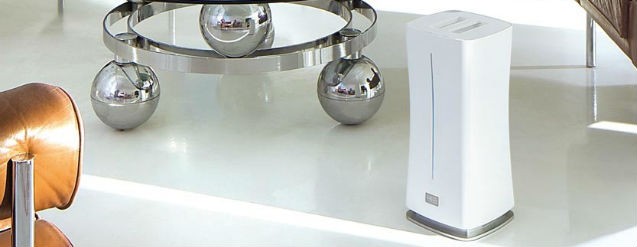Humidifiers increase your indoor humidity level by injecting moisture into dry air in the form of an invisible mist. Often used in winter to ease physical discomforts caused by winter heating, they also alleviate respiratory problems and protect household furnishing year-round.
For easier accessibility to the sections in this article, use our topic list below:
- Why Do You Need a Humidifier?
- Measuring Your Humidity
- Choosing The Right Humidifier
- Convenience Features
- Maintenance and Care
Why Do You Need a Humidifier?
Humidifiers increase your indoor humidity level by injecting moisture into dry air in the form of an invisible mist. Often used in winter to ease physical discomforts caused by winter heating, they also alleviate respiratory problems and protect household furnishing year-round.
Low Humidity Level Health Issues
In the fall and winter, using our home's heating system can warm us up but also dry out the indoor air, leading to health issues like:
- Dry Sinus Passages
- Bloody Noses
- Cracked Lips
- Sore, Scratchy Throat
- Dry, Scaly Skin
- Aggravating Respiratory Ailments
Health and Home Benefits of Humidifiers
Humidifiers help alleviate these dry air symptoms, chronic illnesses like allergies and sinus infections and protect your home's furnishing and belongings.
- Soothing Moisture: The moisturizing mist that a humidifier adds to the air soothes breathing passages, making it easier for air to pass through.
- Respiratory Medication: Some humidifiers feature special medicine cups that allow respiratory medications to be released into the air along with the mist.
- Home Interior: Dry air can cause wallpaper and paint to peel, wood flooring and furniture to contract and warp. Regularly running a humidifier will eliminate these problems.
- Static Electricity: Eliminate unexpected shocks and prevent damage to electrical equipment.
- Valuables: Humidifiers can protect musical instruments and fine art from damage.
Measuring Your Humidity
To maintain the proper indoor humidity level, you need to be able to measure it. Measuring humidity levels in real-time is simple, quick and inexpensive with a digital hygrometer.
These battery-operated devices display accurate readouts of your current humidity level and temperature, and some include extra features such as Celsius/Fahrenheit conversion, humidity level alerts, and backlighting.
Many humidifiers include built-in hygrometers and humidity controls sensors known as humidistats to help you precisely measure and adjust your home's humidity.
To learn more about humidity and the importance of monitoring it indoors, read our article Understanding Relative Humidity.
Choosing The Right Humidifier

Finding the right humidifier for you is as easy as determining the humidifier style and type that best fits your space and your individual needs.
Humidifier Styles
At its most basic level, there are essentially two styles of humidifiers:
- Standalone Humidifiers: These humidifiers plug into standard residential electrical outlets and can be tabletop humidifiers for adding moisture to single rooms and large console humidifiers that humidify multiple rooms or even whole homes.
- HVAC/Ducted Humidifiers: Installing directly onto your home's heating and cooling system, HVAC/ducted humidifiers use your home's existing ductwork to disperse moisture throughout your entire home. Learn more in our Furnace Humidifier Buying Guide.
Standalone Humidifier Types
In addition to choosing a humidifier style, you need to know what type of humidifier you want. Humidifier type typically refers to the type of mist it creates, and there are several to choose from.
- Cool Mist: When compared to other models, cool mist humidifiers use less electricity and are safe to use in homes with children and pets. They do contain more moving parts and can be slightly noisier.
- Warm Mist: A warm mist humidifier uses a heating element to boil water, creating a warm mist that's released into your air. Warm mist is great for a little extra relief when you're sick and it can help your room feel slightly warmer too. Because they heat the water, they're not the best option for a child's room or nursery. Some warm mist humidifiers are also known as steam humidifiers.
- Other Common Humidifier Types: As you look at humidifiers you may see other humidifier types including air washers which remove allergens and impurities from your air as it humidifies, aroma diffusers that deodorize your space, evaporative humidifiers that use a wick filter to absorb water and release moisture into your space, and ultrasonic humidifiers that use high-frequency sound waves to create a soothing mist.
Dig in more to the differences in cool mist and warm mist humidifiers in this handy guide and be sure to check out our best tabletop humidifiers.
Convenience Features

Today’s humidifiers include a variety of features and controls that make operation more convenient. Some notable ones to look for include:
- Variable Speeds – Lets you control a humidifier’s moisture output and limit power usage. Multiple speeds also help you adjust the noise level.
- Automatic Shutoff – Automatic shutoff controls turn off the unit when the water reservoir empties. This is important for safety reasons as well as for energy efficiency.
- Indicator Lights – Let you know when the humidifier’s water supply low, when filters need to be replaced, an when its time to clean your humidifier.
- UV Germicidal Light – An ultraviolet humidifier features internal ultraviolet (UV) germicidal lights that kill waterborne germs, bacteria, and mold before the water is released as a mist. This feature is especially beneficial to allergy- and asthma-sufferers.
- Air-Cleaning Pre-Filter – Great for allergy-sufferers, this filter helps rid air of dust particles, pollen, pet dander, and mold before it is humidified and released.
- Digital Control Panel – Digital measurements let you know exactly where your humidity falls and help you make precise changes.
- Demineralization Cartridge - A demineralization cartridge removes mineral content from your water to reduce the risk of white dust caused by hard water.
Maintenance and Care
 Humidifiers require proper maintenance. All humidifiers need regular cleaning and disinfection in order to curb bacteria, mold, and mineral growth. If this is not performed, impurities can be released into the air you breathe. Overtime, breathing contaminated air may aggravate allergies and asthma, trigger flu-like symptoms, and contribute to a lung infection.
Humidifiers require proper maintenance. All humidifiers need regular cleaning and disinfection in order to curb bacteria, mold, and mineral growth. If this is not performed, impurities can be released into the air you breathe. Overtime, breathing contaminated air may aggravate allergies and asthma, trigger flu-like symptoms, and contribute to a lung infection.
As a rule of thumb, if you use your humidifier on a daily basis, you should clean it at least once a week. Follow the manufacturer’s instructions in your product manual for how to clean and care for your unit.
To help reduce the amount of mineral deposits that may develop, consider using distilled or de-mineralized water instead of tap water in your humidifier. Remember to change any filters and special parts on a regular basis as well. Read our article Tips for Maintaining Your Humidifier for more information.
In Summary
Finding the right humidifier depends on your home's individual needs, as well as selecting the right capacity humidifier for your room size.
Still Have Questions?
We know choosing a humidifier isn't an easy decision. To learn more about humidifiers, visit our Humidifier Knowledge Center. Not sure what's best for you? We can take the guesswork out of decision-making. Call us at 1-800-934-9194. We want to help make your indoors healthy and comfortable.


